The Cobs Biofeedback Platform as an alternative in the evaluation of patients with Parkinson's
Keywords:
rehabilitation program, Parkinson's disease, Cobs Biofeedback platform.Abstract
Introduction: At the International Center for Neurological Restoration (CIREN) we have high-tech and robotic equipment for rehabilitation, such as the Cobs Biofeedback platform, an informative response device and therapeutic training of locomotor functions such as coordination, balance, posture, balance and strength.
Objective: To determine the balance changes in normal and standing position in patients with Parkinson's disease (PD), included in a neurorehabilitation program at CIREN.
Methods: Thirty patients with PD were studied before and after neurorerestorative treatment using the Cobs Biofeedback platform that measures balance in normal and standing position, for which load (right and left), symmetry index and coordination index were included (right and left).
Results: The comparison of the evaluations before and after the intervention showed a statistically significant decrease for the left load (p ≤ 0.001), the rest of the evaluated variables did not show statistically significant changes. This study confirmed the efficiency of using the Cobs Biofeedback platform by allowing to save all the parameters used during the measurement phases. In this way an objective supervision of the clinical evolution of the patient is achieved.
Conclusions: The Cobs Biofeedback platform makes it possible to quickly and reliably determine objective data on the motor disabilities of patients with PD, which has proven to be one more evaluation option in this type of disease.
Downloads
References
1. Palomino Alonso S. Ejercicio físico en la rehabilitación de la enfermedad de Parkinson. España: Universidad Pública de Navarra, Facultad de Fisioterapia; 2015 [acceso 30/07/2021]. Disponible en: https://hdl.handle.net/2454/18350
2. Armstrong MJ, Okun MS. Diagnosis and treatment of Parkinson disease: a review. Jama. 2020; 323(6):548-60. DOI: https://10.1001/jama.2019.22360
3. Poewe W, Seppi K, Tanner CM, Halliday GM, Brundin P, Volkmann J, et al. Parkinson disease. Nature reviews Disease primers. 2017 [acceso 30/07/2021];3(1):1-21. Disponible en: https://www.nature.com/articles/nrdp201713
4. Abal Durán A. Eficacia de un protocolo de ejercicio terapéutico en pacientes con enfermedad de Parkinson: proyecto de investigación. España: Universidad de la Coruña, Facultad de Fisioterapia; 2019. [acceso 30/07/2021]. Disponible en: http://hdl.handle.net/2183/24011
5. Bresson DP, Ortega Carbajales E, Turon Florenza C. Tai Chi para la prevención de caídas en pacientes con enfermedad de Parkinson en los Estadios I y II de la escala Hoehn y Yahr. España: Escuela Universitaria de Fisioterapia Gimbernat; 2017 [acceso 20/07/2021]. Disponible en: http://hdl.handle.net/123456789/422
6. Silva D, Corrêa JC, de Sá MA, Normando VM, Silva SM, Dal Corso S, et al. Validación y reproducibilidad de la prueba Glittre de actividades de la vida diaria en personas con enfermedad de Parkinson. Revista de neurología. 2019 [acceso 29/07/2021];69(10):395-401. Disponible en: http://hdl.handle.net/123456789/422
7. Gómez-Regueira N, Escobar-Velando G. Tratamiento fisioterapéutico de las alteraciones posturales en la enfermedad de Parkinson. Revisión sistemática. Fisioterapia. 2017 [acceso 29/07/2021];39(1):33-43. DOI: https://doi.org/10.1016/j.ft.2016.02.002
8. Arredondo-Blanco K, Zerón-Martínez R, Rodríguez-Violante M, Cervantes-Arriaga A. Breve recorrido histórico de la enfermedad de Parkinson a 200 años de su descripción. Gaceta Médica de México. 2018; 154(6):719-26. DOI: https://doi.org/10.24875/GMM.18003702
9. Herrera Palacios JM, Ordóñez Pasaje DL, Posada Téllez A, Lendínez-Parra NS. Fisioterapia y balance en deportistas de voleibol sentado en la Selección Colombia de Voleibol Sentado rama masculina. Rev Cuban Invest Bioméd 2014 [acceso 29/07/2021];33(4):356-66. Disponible en: http://scielo.sld.cu/scielo.php?script=sci_arttext&pid=S0864-03002014000400002&lng=es&nrm=iso>
10. Ríos-Tanchiva A, Cisneros-Perdomo V, Falcón-Calzadilla J, Hernández-Chisholm D, Berbes-Villalón L, Pazo-Mollineda P. Eficacia terapéutica de la plataforma Cobs en la calidad de vida de pacientes con enfermedad cerebrovascular. Rev Cub Med Fís Rehabilit. 2016 [acceso 29/07/2021];8(1):87-98. Disponible en: http://revrehabilitacion.sld.cu/index.php/reh/article/view/24
11. Cisneros Perdomo V, Carmona Ferrer B, Cecilia NMD, Hernández Chisholm D, Sánchez Castillo Y. Eficacia de la plataforma Cobs en trastornos de equilibrio, postura y marcha del adulto mayor. Rev Cuban Med Fís y Rehabilit. 2015 [acceso 29/07/2021];7(1):42-54. Disponible en: http://revrehabilitacion.sld.cu/index.php/reh/article/view/111
12. Sabater-Hernández H, Almanza-Díaz Y, Semino-García LE, Toca-Smith S, Berbes-Villalón L. Rehabilitación del ictus. Segunda parte. Rev Cuban Med Fís y Rehabilit. 2016 [acceso 30/07/2021];8(1):125-37. Disponible en: https://www.medigraphic.com/pdfs/revcubmedfisreah/cfr-2016/cfr161k.pdf
13. Dunn-García E, Valdes-Montes N, Sánhez-Castillo Y, Zaldívar-Suárez E, Díaz-Morales C, Méndez-Rionda R, et al. Protocolo para la atención integral al paciente con diagnóstico de parálisis cerebral. Rev Cuban Med Fís y Rehabilit. 2012 [acceso 29/07/2021];4(1). Disponible en: https://www.medigraphic.com/pdfs/revcubmedfisreah/cfr-2012/cfr121a.pdf


